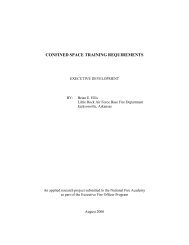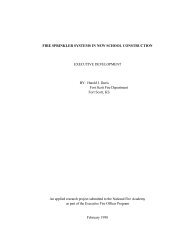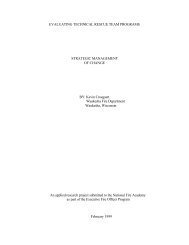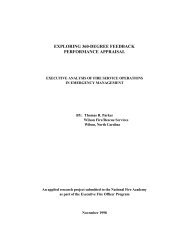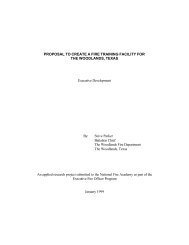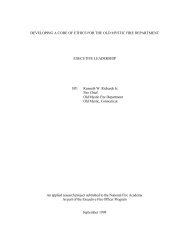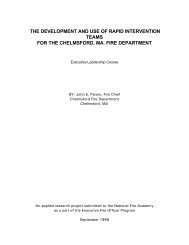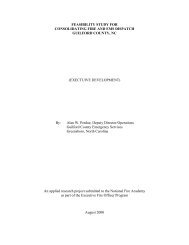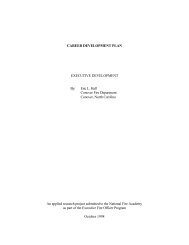Value Statements - US Fire Administration
Value Statements - US Fire Administration
Value Statements - US Fire Administration
Create successful ePaper yourself
Turn your PDF publications into a flip-book with our unique Google optimized e-Paper software.
Format changes have been made to facilitate reproduction. While these research projects have been selected as<br />
outstanding, other NFA EFOP and APA format, style, and procedural issues may exist.<br />
Traditionally, fire service organizations have almost exclusively practiced a top-down<br />
form of management. While this works effectively on the fireground, it is an ineffective form of<br />
management for the majority of issues that confront fire service leaders today. Members are<br />
organizational stakeholders and frequently have the same level of personal, professional, and<br />
emotional commitments to the success of the organization as its leaders. Involving members<br />
increases buy-in, acceptance, and if skillfully orchestrated, the quality of the final product.<br />
Moreover, leaders who allow members to participate in the process maximize the<br />
potential of the organization. Usually there are a limited number of formal positions of<br />
leadership within an organization. However, leaders who create an "entrepreneurial spirit" by<br />
allowing members to participate in the decision making process create an environment where<br />
members can learn and develop leadership skills for future application. In years to come, this<br />
will become a requisite skill for fire service leaders. This perspective is in accord with those of<br />
Blanchard and Hersey (1993) who admonish that members' commitment to organizational goals<br />
and objectives are increased if members are able to participate in the process. Additionally,<br />
"Leaders must be able to gain consensus on a common cause and a common set of principles.<br />
They must be able to build a community of shared values" (Beckhard et al., 1996, p. 105).<br />
Conversely, when members are not allowed to participate in the process, will in time,<br />
give up and devote their heart to outside interests that will eventually get best efforts. The net<br />
effect will be the organization will be left with only with their physical bodies. Covey<br />
(1989, p. 58) wrote, "You can buy a person's hand, but you can't buy his heart. His heart is<br />
where his enthusiasm, his loyalty is...You can't buy his brain. That's where his creativity is, his<br />
ingenuity, his resourcefulness."<br />
The organizational implications as a result of this study are:<br />
1. <strong>Value</strong> statements will furnish the leadership of the GFD a stabilizing rudder as the<br />
department endures a 56-percent organizational personnel metamorphosis by the<br />
year 2010.<br />
2. <strong>Value</strong> statements will formalize our organizational culture by providing<br />
standardized written parameters for organizational members to measure behavior<br />
and decision making with.<br />
3. <strong>Value</strong> statements will provide a filtering device to members of the organization<br />
who are responsible for promotional selection processes to assist in assessing<br />
critical behaviors and attributes of candidates who aspire to supervisory and<br />
administrative positions.<br />
- 180 -





